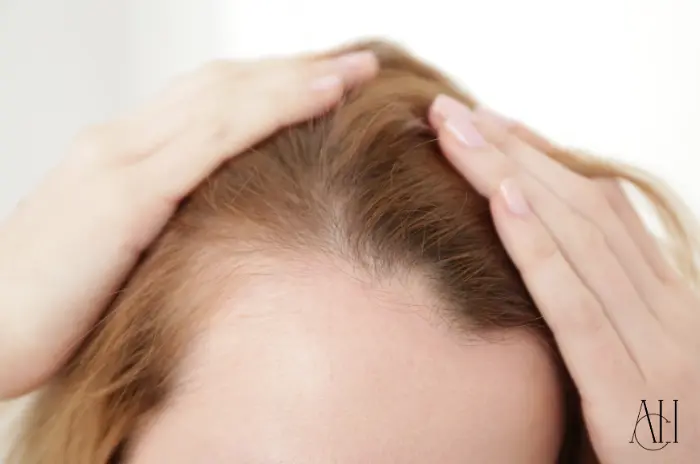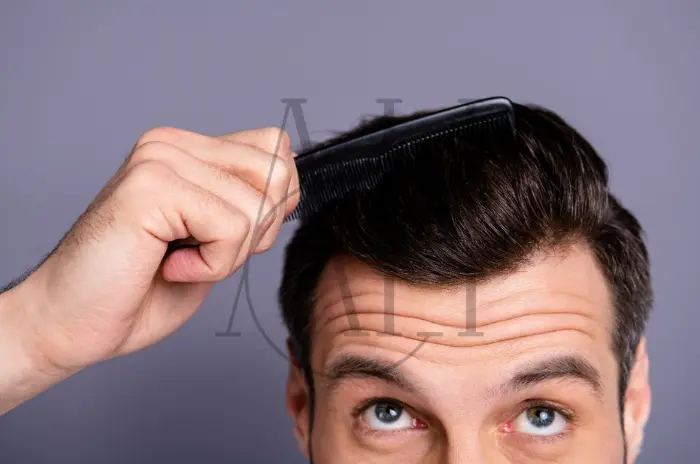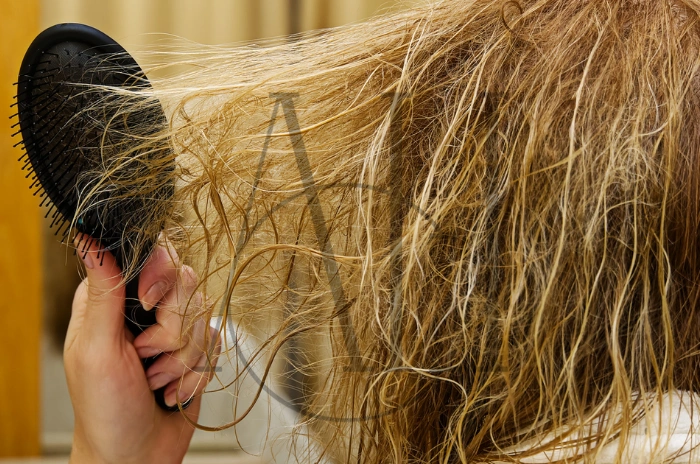A receding hairline in women is becoming an increasingly recognized concern, affecting millions of women worldwide who experience gradual hair loss at their temples and frontal hairline. Unlike the traditional perception that hairline recession primarily affects men, female hairline changes can be just as distressing and require specialized understanding and treatment approaches. Hair loss in women often manifests differently than in men, making it crucial to identify the specific patterns and causes unique to female pattern hair loss.
Understanding receding hairline women face is essential for early intervention and effective treatment. The condition can significantly impact self-confidence and quality of life, but with proper diagnosis and modern hair loss treatment options, many women can successfully address their hairline concerns. From topical medications like minoxidil for women hairline to advanced procedures such as hair transplant for women hairline, various solutions exist to help restore and maintain a healthy hairline.
Table of Contents
ToggleWhat Is a Receding Hairline in Women?
A receding hairline in women refers to the gradual backward movement of the hairline from its original position, typically affecting the temples and frontal areas of the scalp. This condition differs significantly from general hair thinning and requires specific identification methods to ensure proper treatment.
Recognising Female Hairline Recession Patterns
Female hairline recession typically follows distinct patterns that differ from male pattern baldness:
- The hairline may recede in a subtle, diffuse manner rather than forming distinct M-shaped patterns
- Women hairline recession often begins with gradual thinning at the temples before becoming more noticeable
- The frontal hairline may appear uneven or develop small gaps that progressively widen over time
How a Receding Hairline Differs from General Thinning
Understanding the distinction between receding hairline women experience and overall hair thinning is crucial:
- Receding hairlines specifically affect the hairline position, moving it backward from its original location
- General thinning affects hair density throughout the scalp without necessarily changing the hairline position
- Female pattern hair loss at the hairline creates visible changes in facial framing, while general thinning may not alter the hairline shape
Early Signs of a Receding Hairline in Women
Recognizing early treatments for receding hairline women begins with identifying initial symptoms:
- Increased forehead visibility due to backward hairline movement
- Temple areas appearing less dense or developing small bald patches
- Changes in how hair frames the face, creating an aged appearance
Common Causes of Receding Hairline in Women
The causes of receding hairline in women are multifaceted and understanding them is essential for developing effective treatment strategies. Various factors contribute to hair loss at temples women experience, ranging from genetic predisposition to environmental influences.
Genetics and Female Pattern Hair Loss
Female pattern hair loss hairline changes often stem from genetic factors:
- Inherited sensitivity to dihydrotestosterone (DHT) can cause follicle miniaturization
- Family history of hair loss increases the likelihood of developing hairline recession
- Genetic factors typically manifest gradually over years rather than sudden onset
Ageing and Menopause‑Related Hair Recession
Hormonal hair loss women experience during menopause significantly impacts hairline health:
- Declining estrogen levels reduce hair follicle protection against DHT
- Post-menopausal women often experience accelerated hairline changes
- Age-related hormonal shifts can trigger previously dormant genetic predispositions
Stress and Telogen Effluvium Effects
Stress-related hair loss women face can directly impact hairline density:
- Chronic stress pushes hair follicles into resting phase prematurely
- Telogen effluvium hairline effects can cause temporary but noticeable recession
- Emotional or physical stress events may trigger delayed hairline changes
Nutritional Deficiencies: Iron, B12, Biotin
Nutritional deficiencies hairline problems arise from inadequate nutrient intake:
- Iron deficiency affects oxygen delivery to hair follicles
- Vitamin B12 deficiency can cause hair weakness and premature loss
- Biotin insufficiency impacts keratin production essential for healthy hair growth
Traction Alopecia from Tight Hairstyles
Traction alopecia women develop from repetitive hair tension:
- Tight ponytails, braids, or hair extensions create constant follicle stress
- Repeated pulling gradually weakens hair roots at the hairline
- Early intervention can prevent permanent follicle damage
Frontal Fibrosing Alopecia in Women
Frontal fibrosing alopecia women represents a specific inflammatory condition:
- This scarring alopecia primarily affects the frontal hairline and eyebrows
- Progressive inflammation destroys hair follicles permanently
- Early diagnosis and treatment are crucial for preventing extensive loss
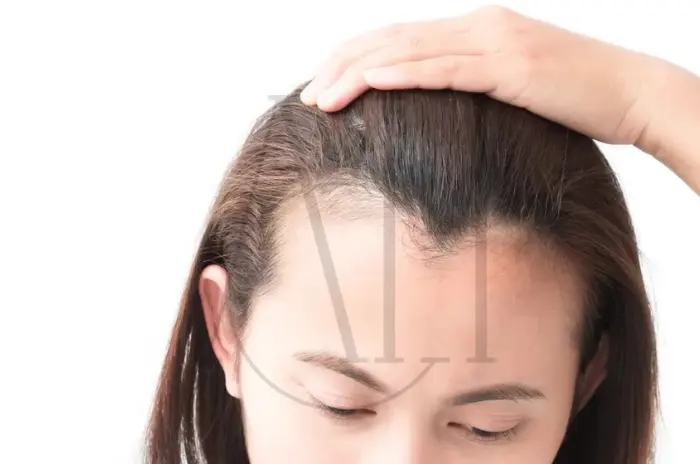
Hormonal Changes and Hair Loss in Women
Hormonal hair loss women experience extends beyond menopause:
- Pregnancy and postpartum periods can trigger temporary hairline changes
- Pregnancy hairline thinning often resolves naturally within months
- Thyroid disorders can significantly impact hairline density and growth patterns
Environmental Harm and Harsh Chemicals
External factors contribute to causes receding hairline women experience:
- Chemical hair treatments can weaken follicles over time
- Environmental pollution and UV exposure damage hair structure
- Heat styling tools create thermal damage affecting hairline health
Trichotillomania and Hairline Damage
Compulsive hair pulling specifically targets accessible hairline areas:
- Repetitive pulling behavior creates localized hair loss patterns
- Hairline areas are particularly vulnerable due to easy accessibility
- Professional intervention addresses both hair loss and underlying behavioral patterns
Female Pattern Hair Loss (FPHL)
Female pattern hair loss represents the most common cause of hairline recession:
- Androgenetic alopecia affects up to 50% of women over age 50
- Progressive miniaturization reduces hair diameter and length
- Early intervention provides the best outcomes for maintaining hairline density
Recognising Symptoms of Hairline Recession
Identifying the symptoms of receding hairline in women early enables prompt intervention and better treatment outcomes. Female hairline changes often develop gradually, making awareness of specific warning signs crucial for timely action.
Hair Moving Back in M, V, or U Shapes
Receding hairline women often notice distinct shape changes in their hairline:
- M-shaped patterns develop when temple areas recede more than central hairline
- V-shaped recession creates a pointed appearance at the center of the forehead
- U-shaped patterns indicate broader, more uniform hairline retreat
Reduced Hair Density at the Front
Hair loss at the frontal hairline manifests as density changes:
- Individual hairs become finer and shorter over time
- Spaces between hairs gradually widen, creating visible scalp areas
- Overall volume at the hairline decreases even before obvious recession occurs
Uneven Hairline and Visible Hair Shedding
Women hairline recession often presents as asymmetrical changes:
- One side may recede faster than the other, creating uneven appearance
- Increased hair shedding during washing or brushing indicates active loss
- Irregular hairline edges replace previously smooth, defined borders
Widows Peak vs. Receding Hairline in Women
Distinguishing between natural hairline variations and female pattern hair loss is essential:
- Natural widow’s peaks remain stable throughout life
- Receding hairline involves progressive backward movement from original position
- Photographic comparison over time helps differentiate natural variation from recession
How to Diagnose Receding Hairline in Women
Proper diagnosis of receding hairline women experience requires systematic evaluation and measurement techniques. Accurate assessment helps distinguish between temporary hair loss and progressive female hairline recession requiring intervention.
Look for Hairline Change of Over 1.5 cm
Hair loss treatment decisions often depend on measuring actual recession distance:
- Comparing current photos with older images reveals hairline position changes
- Measuring from eyebrow to hairline helps quantify recession extent
- Changes exceeding 1.5 cm typically indicate significant receding hairline in women
Spotting Thinner Hair or Wider Parting
Female pattern hair loss often manifests as density changes before obvious recession:
- Part lines gradually widen as hair density decreases
- Individual hair strands become finer and less pigmented
- Overall hair coverage appears less dense even without obvious hairline movement
Measuring Hairline Shift and Temple Thinning
Causes receding hairline women can be confirmed through systematic measurement:
- Temple area evaluation reveals early recession patterns
- Comparing hairline position to facial landmarks provides objective assessment
- Progressive measurement over time confirms active versus stable hair loss
Effective Treatments for Women’s Receding Hairline
Modern treatment receding hairline women includes various evidence-based options ranging from topical medications to surgical interventions. Best treatment for women’s receding hairline depends on the underlying cause, severity, and individual patient factors.
Minoxidil: Daily Topical Medication
Minoxidil for women hairline represents the gold standard for non-surgical hair loss treatment:
- FDA-approved 2% and 5% formulations specifically designed for women
- Daily application stimulates blood flow to hair follicles and prolongs growth phases
- Clinical studies demonstrate significant improvement in hairline density within 3-6 months
Addressing Nutritional Gaps with Supplements
Vitamins for hairline growth women can support natural hair restoration:
- Iron supplementation addresses deficiency-related hair loss
- Biotin, vitamin D, and B-complex vitamins support healthy hair growth
- Nutritional deficiencies hairline problems often improve with targeted supplementation
Using Hair Oils Like Rosemary & Pumpkin Seed
Natural oils offer non-surgical hairline solutions women can incorporate into daily routines:
- Rosemary oil studies show comparable effectiveness to 2% minoxidil
- Pumpkin seed oil may inhibit DHT production naturally
- Regular scalp massage with these oils improves circulation and follicle health
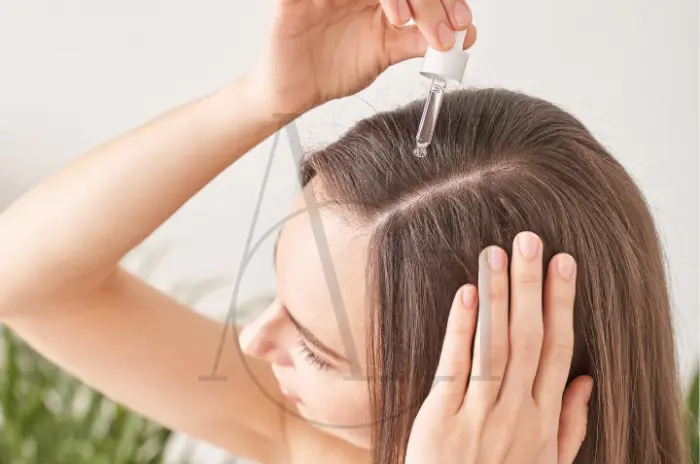
PRP Therapy to Boost Follicle Growth
PRP treatment hairline women utilizes the body’s natural healing factors:
- Platelet-rich plasma injections deliver growth factors directly to follicles
- PRP treatment for women’s hairline shows promising results in clinical trials
- Treatment series typically involves 3-4 sessions spaced monthly for optimal results
Hair Transplant Options (FUE Method)
Hair transplant for women hairline offers permanent solutions for advanced recession:
- Follicular Unit Extraction (FUE) minimizes scarring and recovery time
- Hair transplant for women requires careful donor site evaluation and artistic planning
- Modern techniques achieve natural-looking hairlines with minimal downtime
Why DHT-Blockers Like Finasteride Are Not Recommended
Understanding limitations of certain hair loss treatment options for women:
- Finasteride carries significant risks for women of childbearing age
- Hormonal side effects can be severe and long-lasting
- Alternative DHT-blocking strategies focus on topical or natural approaches
Lifestyle Tips to Support Hairline Health
Implementing comprehensive hair loss prevention for women strategies supports both treatment outcomes and overall scalp health. These lifestyle modifications complement medical treatments and help maintain female hairline health long-term.
Manage Stress with Exercise and Sleep
Stress-related hair loss women can be significantly reduced through lifestyle modifications:
- Regular exercise reduces cortisol levels that contribute to hair loss
- Adequate sleep (7-9 hours) supports natural hair growth cycles
- Stress management techniques like meditation improve overall scalp health
Eat a Balanced Diet Rich in Hair‑Supporting Nutrients
Nutrition plays a crucial role in maintaining healthy women hairline recession prevention:
- Protein intake supports keratin production essential for strong hair
- Omega-3 fatty acids reduce inflammation that can damage follicles
- Antioxidant-rich foods protect hair follicles from environmental damage
Avoid Tight Hairstyles to Prevent Traction Damage
Preventing traction alopecia women requires mindful styling choices:
- Loose hairstyles reduce constant tension on hairline follicles
- Alternating hairstyles prevents repetitive stress on the same areas
- Protective styling techniques preserve hairline integrity during sleep and exercise
The Difference Between Male and Female Hairline Recession
Understanding the distinctions between receding hairline patterns in men and women helps ensure appropriate treatment selection. Female pattern hair loss hairline changes follow different patterns and timelines compared to male androgenetic alopecia.
Female hairline recession typically develops more gradually and diffusely than male pattern baldness. Women rarely develop the dramatic M-shaped recession characteristic of male hair loss, instead experiencing subtle backward movement and density reduction. Receding hairline women face often maintains some frontal hair coverage even in advanced stages, while men may develop complete frontal baldness.
Hormonal influences also differ significantly between genders. Hormonal hair loss women experience is more closely tied to estrogen fluctuations, particularly during menopause, pregnancy, and hormonal transitions. Men’s hair loss is primarily driven by DHT sensitivity, which affects women differently due to protective estrogen levels during reproductive years.
Treatment responses vary between genders as well. Treatment receding hairline women often requires different medication dosages and approaches compared to male treatments. Hair transplant for women hairline procedures require more conservative harvesting and artistic placement to maintain feminine hairline characteristics.
Non-Surgical Solutions for Female Hairline Loss
Non-surgical hairline solutions women provide effective alternatives to invasive procedures, offering various options for addressing female pattern hair loss without surgery. These treatments focus on stimulating existing follicles and improving overall scalp health.
Laser Therapy for Thinning Hairlines
Laser therapy for women hair loss utilizes low-level light therapy to stimulate follicles:
- FDA-cleared devices deliver specific wavelengths that enhance cellular energy production
- Home-use devices offer convenient daily treatment options
- Clinical studies demonstrate improved hair density and thickness with consistent use
Topical Treatments and Their Effectiveness
Non-surgical hairline restoration women benefits from various topical formulations:
- Prescription-strength minoxidil provides the most robust clinical evidence
- Peptide-based serums support follicle health and growth factor production
- Combination therapies often yield better results than single-ingredient treatments
Camouflage Techniques for Immediate Results
Temporary solutions provide confidence while pursuing long-term treatments for receding hairline women:
- Hair fibers and powders instantly conceal thin areas
- Strategic styling techniques minimize hairline recession appearance
- Quality wigs and hairpieces offer versatile coverage options
Surgical Hair Restoration for Women
Hair transplant for women represents the most definitive solution for advanced receding hairline in women. Modern surgical techniques offer natural-looking results with minimal scarring and downtime.
How FUE Transplants Work for Female Patients
Hair transplant for women hairline procedures require specialized techniques:
- Individual follicle extraction preserves surrounding hair density
- Careful donor site selection maintains overall hair distribution
- Artistic placement creates naturally feminine hairline characteristics
What to Expect During Hair Transplant Recovery
Hairline lowering surgery women undergo requires understanding the hair transplant recovery period and healing process:
- Initial healing occurs within 7-10 days with minimal discomfort
- Transplanted hairs shed within 2-4 weeks before new growth begins
- Final results become apparent 12-18 months after the procedure
Long-Term Results of Hairline Restoration
Your hair journey after surgical restoration involves realistic expectations:
- Transplanted follicles maintain their original growth characteristics permanently
- Natural aging may affect surrounding non-transplanted hair over time
- Proper maintenance and follow-up care optimize long-term outcomes
| Treatment Option | Effectiveness | Timeline | Maintenance Required |
|---|---|---|---|
| Minoxidil | Moderate to High | 3-6 months | Daily application |
| PRP Therapy | Moderate | 2-4 months | Quarterly sessions |
| Hair Transplant | High | 12-18 months | Minimal |
| Laser Therapy | Low to Moderate | 6-12 months | Regular use |
| Nutritional Support | Variable | 3-9 months | Ongoing |
FAQ : Receding Hairline in Women Causes Symptoms and Effective Treatments
What does a receding hairline in women look like, and how is it different from general thinning?
A receding hairline in women appears as backward movement of the hairline from its original position, particularly at temples, while general thinning affects overall hair density without changing hairline position.
What are the most common causes of a receding hairline in women?
The most common causes of receding hairline in women include genetic predisposition, hormonal changes during menopause, chronic stress, nutritional deficiencies, and traction alopecia from tight hairstyles.
Can a receding hairline in women be a sign of an underlying medical condition?
Yes, female hairline recession can indicate conditions like thyroid disorders, frontal fibrosing alopecia, autoimmune diseases, or hormonal imbalances requiring medical evaluation.
Are there effective non-surgical treatments to stop or reverse a receding hairline in women?
Non-surgical hairline restoration women can benefit from minoxidil for women hairline, PRP treatment, laser therapy, and nutritional supplementation with proven effectiveness.
Is a hair transplant a viable solution for women with a receding hairline?
Hair transplant for women hairline is viable for appropriate candidates with adequate donor hair and realistic expectations about natural-looking results.
How can diet and lifestyle choices impact a woman's receding hairline?
Diet rich in vitamins for hairline growth women, stress management, adequate sleep, and avoiding tight hairstyles significantly support hair loss prevention for women.
What is Frontal Fibrosing Alopecia, and how does it relate to a receding hairline in women?
Frontal fibrosing alopecia women is a scarring condition that specifically targets the frontal hairline and eyebrows, requiring early intervention to prevent permanent loss.
What are the key differences between male and female hairline recession?
Female pattern hair loss develops more gradually and diffusely than male pattern baldness, rarely creating dramatic M-shaped patterns and maintaining some frontal coverage even in advanced stages.

